Today, to keep up with user retention and engagement, you need a mobile app that meets your users’ expectations. But effective mobile app development isn’t easy, and the rules and technology are in constant flux. A well-designed mobile app not only allows users to make purchases, gather information, and reach out to your company, it also needs a user-friendly interface, features they expect, and the ability to protect their sensitive data.
With the latest trends in mobile app development, unique features and flawless design elements separate the winners from the duds.; just consider how many apps are available in the Apple Store and Google Play.
So, without further delay, let’s take a look at the top 15 features your app needs to set it apart from the crowd.
Table of Contents
Mobile App Features You Need
Responsive Interface
Trying to create a mobile app design for every screen size and resolution is an effort in futility; there are simply too many. The answer to this problem is responsive app design. This allows your app to adjust to any screen size and resolution – including all smartphones and tablets – automatically. By incorporating a responsive design during the application development phase, you ensure that users will have the best possible view of your app at all times, regardless of the device they use.
Simplicity of Design
As mobile app design has advanced, aesthetics have become a major concern for developers. Regardless of the complexity of your app, or even what user problems it solves, users expect an uncluttered and straightforward design. Your elements need to be placed in their proper context, space, and size to make the user experience seamless.
Today’s mobile app users expect their apps to be easy-to-use and -navigate. Otherwise, they’re likely to stop using it, quickly. In fact, 90% of users have stopped using an app due to poor performance. This is where strong user interface (UI) and user experience (UX) design can help elevate your app to the next level.
Security-By-Design
Cybersecurity is a growing concern for nearly every industry. That means it should be a foundational aspect for any mobile app development process. Therefore, developers need to take a “shift-left” approach to building their apps; testing for security defects and vulnerabilities throughout the entire developmental process – from ideation to architecture, execution, testing, and release.
Chat Support
As user expectations for mobile apps have risen, the need for chat support has become more apparent. If a user is accessing your app’s support functions, that means they’ve encountered a problem, and they’re likely upset. Asking them to leave the app and navigate to a website – or worse, make a phone call and wait on hold – only compounds frustrations.
Adding a chat support feature makes getting that help seamless, quick, and easy. What’s more, it’s a perfect opportunity to enhance the user experience and create more customer growth.
Privacy Options
Nearly every modern app needs to process personal user data with the strongest privacy and security possible to stay compliant with regulatory requirements. But beyond regulations, your app should include highly apparent privacy notifications. Including upfront privacy notifications shows that you care about your users’ data. This, in turn, enhances your users’ perception of your brand identity and improves the overall user experience.
Multi-Factor Authentication
Now, more than ever before, there needs to be a balance between data accessibility and data protection. Consequently, any app that provides access to sensitive information should have multi-factor authentication built in as the standard for user validation and access. This kind of security should be at the heart of your mobile application development.
Push Notifications
According to Airship’s 2021 Push Notification Benchmark report, the opt-in rate for app push notification among Android users is, on average, 81%. For iOS users, this number is 51%. The higher value for Android is due to the fact that iOS users must actively consent to push notifications, while Android enables them automatically. This makes push notifications a highly effective way of connecting with users.
By integrating push notifications into your app, you have a direct way of communicating with users. Moreover, you can offer them exactly what they want to see. Additionally, push notifications are highly customizable, and can be tailored for each user. For example, if your app caters to local sports fans, you can send them a push notification telling them when the next game starts, or the score of the most recent match.
Search Function
An advanced search feature helps users explore every corner of your app to find exactly what they’re looking for. This small feature has a huge impact, especially if your app offers a large amount of content; a vast library can quickly become frustrating for users if they can’t find what they need. Top-tier apps utilize an advanced search function to help their users find relevant information through the use of keywords and phrases. This makes all the app’s contents accessible to every user.
Social Media Integration
As social media has grown, the days of simply sharing a status update or your most recent photos have fallen to the wayside. Now, through social media integration, many apps allow users to communicate and cooperate with others, regardless of whether they’re using the same app or not.
Additionally, with social media integrated into your app, you reap the extra advantage of users sharing more content. This, in turn, adds to your own organic reach and growth. The key is to make sure the integration with social platforms is seamless; e.g. adding social sharing buttons to every page of the app.
Tutorials
As apps have become more complex and offer more and varied features, tutorial or “how-to” screens have become a must. Chances are your app will have a wide variety of users, many of whom may not be the most tech-savvy. The best way to engage with all of your audiences is to provide guides after the initial download and updates to maximize the use of each newly developed feature.
Multi-Device Synchronization
Today, it’s common for app users to start on one device, and then move to another. Consider this example: you’re filling out a form within a mobile app, only to find that it’s either too complicated to fill out on your smartphone’s relatively small screen, or that you’d simply prefer to finish it on a website. Providing your users with the ability to jump from one device or platform to another with real-time multi-device synchronization contributes to a strong user experience and can be invaluable.
AR Integration
Augmented reality (AR) has made a big splash in recent years thanks to mobile games like Pokemon GO. Now, mobile users are eager to experience AR for themselves in an array of applications. Today, developers are on the lookout for new and exciting ways to leverage ARKit for iOS and ARCore for Android. The combination of the real and virtual worlds offers a variety of new experiences for users across industries.
Machine Learning
Data science has become a critical element of many industries. Taking advantage of data science and machine learning models in business apps can help meet the demands of quick and accurate demographic targeting needed for increasing sales and revenue. Furthermore, machine learning provides valuable insights from the analysis of your users’ behavior patterns. This, in turn, helps you create better and more effective outcomes for your application. While this is most obviously a great benefit for e-commerce apps, the advantages extend to other industries as well.
User Feedback Options
Many mobile app users are happy to share their thoughts, feelings, and feedback about their experience using your app. So let them! Offering users the ability to send instant feedback erases any delay in their opinions reaching you. This also means you can make changes requested or suggested by feedback much more quickly and efficiently.
Offline Functionality
While cell phone network signals and wifi have become somewhat ubiquitous, there are situations where a network connection is impossible. For these circumstances, it’s a good idea to allow your mobile app to work even when there is no internet connection available. Additionally, you’ll need to address the issue of data security while working offline. While one would not want sensitive data of any kind to remain on a mobile device, some work should still be possible when offline. That means it’s up to your app’s developers to figure out how to store data and create functionality depending on what your app’s purpose is, and what requirements it has to operate.
Conclusion
By including these features, as well as any others your target research turns up, during your mobile app development, you can ensure you’ll meet your users’ expectations. If you can meet as many of these expectations as possible, the success of your app is that much closer!
Related posts
Recent Posts
Top Cricket Coaching Classes in Kanpur, India
Cricket is a sport that emerged in the medieval era of the world; its style of play and the emotions…
Useful Tips and Tricks to Trade with Bitcoin and to Make Investment Plans in Online Trading
Trade with Bitcoin and to Make Investment Plans in Online Trading Useful Tips & Tricks The kinds of Bitcoin tricks…



